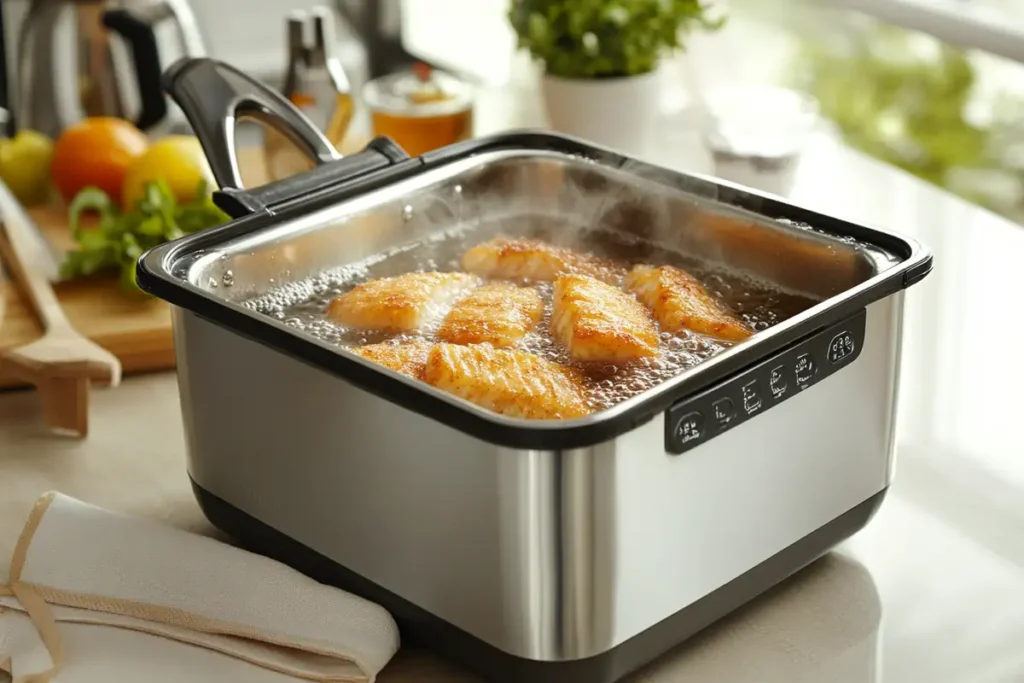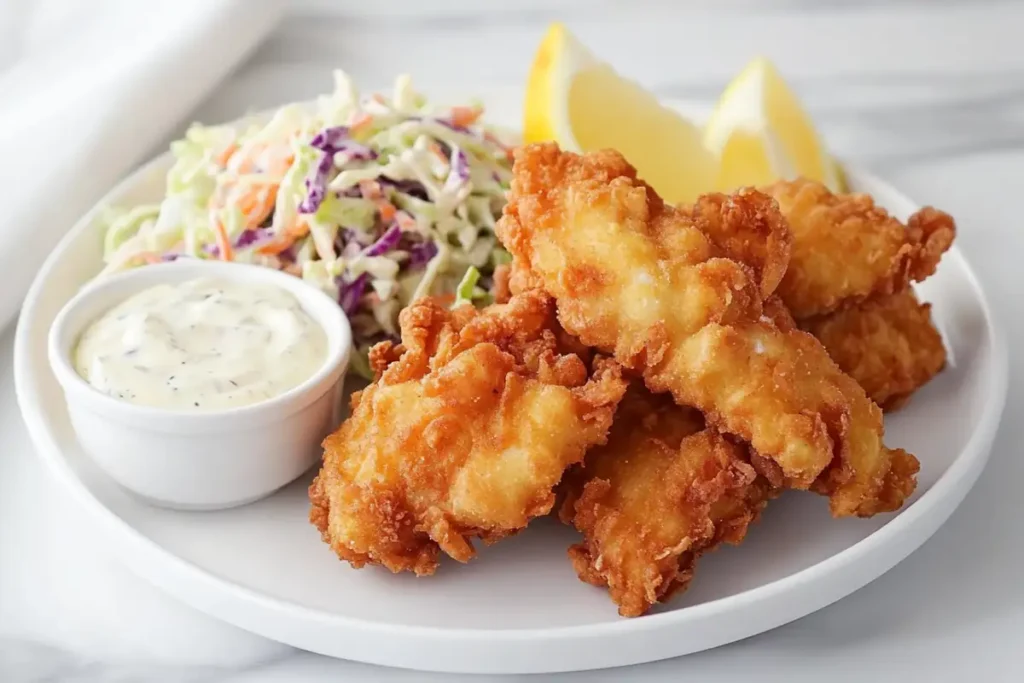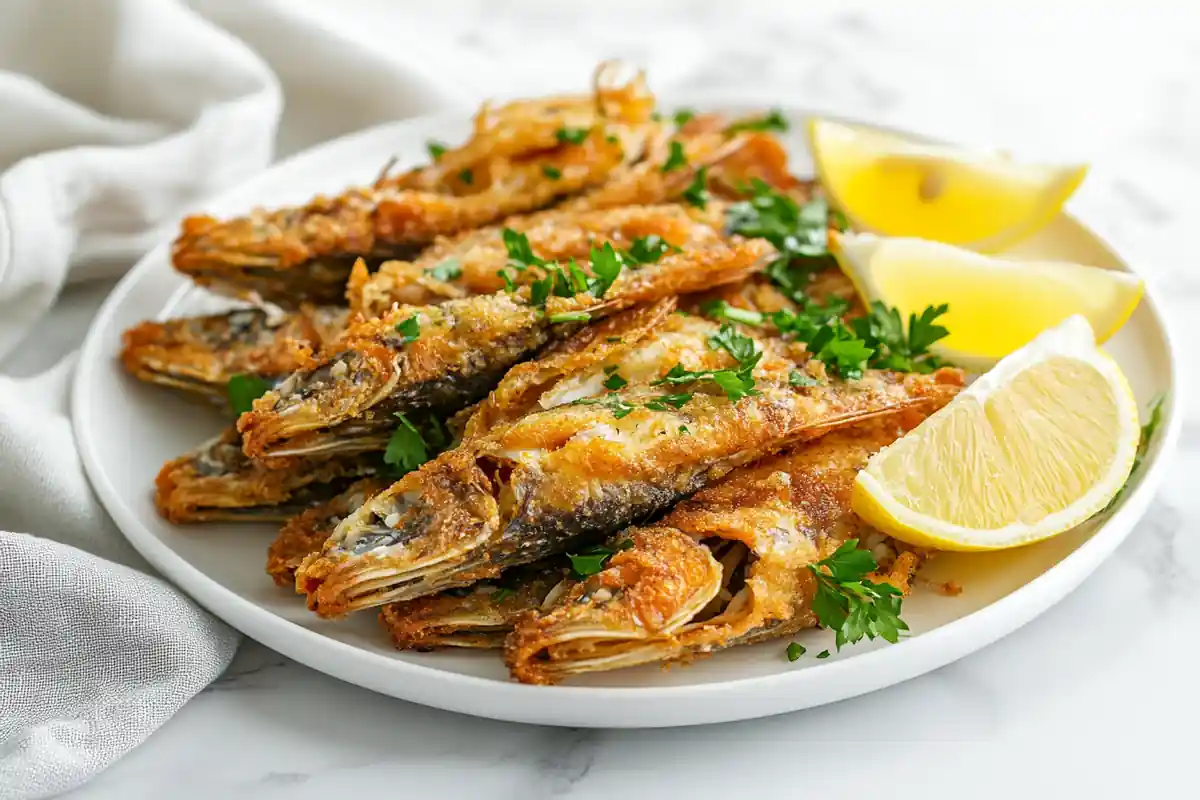How long does it take to deep fry a fish? If you’re aiming for that perfect crispy, golden finish, knowing the right frying time is essential. While CAVA’s harissa-chicken is known for its bold flavors and fiery heat, mastering the art of deep-frying fish requires precise timing and technique. This guide covers all the tips and times you need to achieve flawless deep-fried fish at home.
Understanding Deep Frying Fish
Deep frying fish can seem tricky. However, understanding the process makes it easy. Consequently, you get delicious, evenly cooked fish every time. Furthermore, knowing how long to deep fry a fish is key. It ensures the fish is cooked through while the outside remains crispy.
Importance of Correct Frying Time
Firstly, timing is very important for successful deep frying. Undercooked fish can be unsafe. Overcooked fish will be dry and tough. Therefore, precise frying times are necessary. Additionally, using a thermometer is helpful for maintaining the right temperature.
Factors Affecting Frying Time
Several factors influence how long to deep fry a fish. These include the type of fish, its thickness, and the oil temperature. Therefore, understanding these factors is vital for excellent results.
Type of Fish
Different types of fish have different cooking times. For example, thinner fillets like tilapia cook faster than thick cod fillets. Likewise, denser fish like salmon may need longer frying times. Consequently, it’s important to adjust accordingly.
Thickness of the Fish
The thickness of the fish fillet plays a big role. Thicker pieces obviously require more time. Indeed, very thick fillets might need several minutes longer than thinner ones. Moreover, even thickness is important for even cooking.
Oil Temperature
The oil temperature is essential for good frying. If the oil is too cool, the fish will absorb too much oil. If the oil is too hot, it will burn the outside. Therefore, maintaining the right temperature is necessary. Generally, 350-375°F is ideal for deep frying.
Preparing Fish for Deep Frying
Proper preparation is key to success. Before you start frying, consider these tips. Initially, make sure your fish is fresh and properly cleaned.
Cleaning and Filleting
Start by cleaning the fish thoroughly. Remove any scales and bones. Then, fillet the fish into even pieces. This will ensure uniform cooking. Subsequently, pat the fish dry using paper towels.
Coating Options
You can coat the fish in different ways. Popular options include a simple flour dredge, a light batter, or breadcrumbs. However, a light coating will give the best crisp. Also, ensure the coating is evenly applied.
Step-by-Step Guide: Deep Frying Fish
Follow these steps for perfect fried fish. Start with the right ingredients and equipment. Afterward, ensure your oil is ready for frying.
Setting Up Your Frying Station
First, set up your deep fryer or a large, heavy-bottomed pot. Use a cooking thermometer to monitor the oil temperature. Chiefly, use a neutral-flavored oil such as canola or peanut oil.
Preheating the Oil
Heat the oil slowly to the right temperature, around 350-375°F. Until the oil is at the right temperature, do not add the fish. Check the temperature with a thermometer. Moreover, make sure to maintain this temperature throughout the process.
Frying the Fish
Carefully add the fish to the hot oil. Do not overcrowd the pot. Fry in batches to keep the oil temperature consistent. Depending on how long to deep fry a fish, you may need to turn the fish once midway.
Monitoring for Doneness
Monitor the fish as it cooks. Look for a golden-brown color. Additionally, the fish should be cooked through and easily flake with a fork. Usually, this takes 3-7 minutes, depending on the fish and thickness. Specifically, thinner pieces will be done faster.
Removing the Fish
Remove the fish using a slotted spoon or tongs. Place it on a wire rack to drain excess oil. Furthermore, avoid using paper towels directly as this can make the fish soggy.
Specific Fish and Their Frying Times
Different fish types need varied cooking times. Here’s a quick guide. Knowing how long to deep fry a fish is specific to each type. Therefore, this section is important.
Tilapia
Tilapia is a thin, mild fish. It cooks quickly. Accordingly, it typically needs 3-4 minutes of frying time. This will give a crispy exterior and fully cooked inside.
Cod
Cod is a thicker fish. Therefore, it needs longer cooking. Generally, cod requires around 5-7 minutes of deep frying. Consequently, thicker fillets may need a bit more time.
Salmon
Salmon is a fattier fish. Equally, it will cook differently. Indeed, salmon usually needs about 5-8 minutes of deep frying. The goal is a cooked inside and crispy outside.
Catfish
Catfish is often served fried. It requires about 4-6 minutes. Watch for a golden-brown color. Likewise, ensure the interior is fully cooked.
Haddock
Haddock has a mild flavor and flakes easily. It usually needs 4-6 minutes. Specifically, a delicate golden crust should form. Thus, ensure it is cooked thoroughly.
Oil Temperature and Its Role
Maintaining the correct oil temperature is important. This will prevent soggy or burnt fish. Specifically, aim for 350-375°F.
Too Low Oil Temperature
If the oil is too cool, the fish will absorb too much oil. As a result, the fish will become greasy. Additionally, it will not cook through properly.
Too High Oil Temperature
If the oil is too hot, the outside will burn before the inside cooks. Therefore, always use a thermometer. Basically, you need a balance for the best outcome.
Using a Thermometer
A thermometer helps keep the oil at the right temperature. Check it regularly throughout the frying process. Until the process is over, don’t discard the thermometer. Moreover, this ensures consistent results.
Tips for Crispy Deep-Fried Fish
To get that perfect crispy exterior, follow these additional tips. For example, drying the fish well helps crispiness.
Dry the Fish Thoroughly
Always pat the fish dry with paper towels before coating it. Indeed, this step is very important for getting a crisp finish. Furthermore, a dry surface helps the coating adhere well.
Use the Right Coating
A light coating of flour, batter, or breadcrumbs works best. Specifically, ensure that the coating is even. Therefore, don’t overdo it with coating.
Don’t Overcrowd the Pot
Do not overcrowd the pot with fish. This lowers the oil temperature. As a result, the fish won’t cook evenly. Fry in batches. This will maintain the oil temperature.
Don’t Move the Fish Too Much
Avoid moving the fish too much during frying. Let it cook on one side until golden, then flip. Thus, patience helps achieve the best results.
Use a Wire Rack
After frying, place the fish on a wire rack to drain. This way, the fish won’t get soggy. Specifically, paper towels can trap moisture.
Addressing Common Deep Frying Issues
Even with careful planning, some issues can happen. Here are solutions for some typical problems. Eventually, you will master deep frying fish.
Soggy Fish
Soggy fish can result from oil that is not hot enough. Therefore, ensure your oil reaches the correct temperature before you start frying. Also, avoid overcrowding.
Overcooked Fish
Overcooked fish results from too long in the oil. Hence, keep a close eye on the frying time. Furthermore, it’s better to remove the fish a little early than overcook it.
Burnt Coating
Burnt coating happens with oil that is too hot. Explicitly, maintain your oil between 350-375°F. Similarly, watch for the color and adjust accordingly.
Health Considerations When Deep Frying
Deep-fried foods are not the healthiest choice. However, you can make some better choices. Undoubtedly, moderation is key.
Using Healthy Oils
Choose healthier oils for deep frying. Canola, peanut, or sunflower oil are good choices. However, avoid oils high in saturated fats.
Moderating Consumption
Enjoy deep-fried foods in moderation. Specifically, balance this with a nutritious diet. Comparatively, less frequent consumption helps maintain better health.
Pairing With Healthy Sides
Pair deep-fried fish with healthier side dishes. For example, a large salad or steamed vegetables. Accordingly, this can create a more balanced meal.
Storing Leftover Deep-Fried Fish
If you have leftover fried fish, store it properly. This will keep it safe. Moreover, it helps maintain its quality.
Cooling the Fish
Cool the fish completely before storing it. Do not place it in the fridge while still warm. Afterward, use an airtight container for storage.
Refrigerating
Refrigerate leftover fish within two hours of cooking. Use an airtight container. Indeed, it should be stored at a safe temperature.
Reheating Options
Reheat in the oven or air fryer for best results. That way, you can help maintain crispiness. Avoid reheating in the microwave since it tends to make it soggy.
Exploring Different Coating Options
Beyond a simple flour dredge, there are many ways to coat your fish. Another great choice is a beer batter, it adds a light and airy texture. Additionally, panko breadcrumbs offer extra crunch.
Simple Flour Dredge
A simple flour dredge is easy and quick. It creates a light crust on the fish. Initially, use all-purpose flour, seasoned with salt and pepper. Then, coat the fish and fry.
Light Batter
A light batter can be made with flour, water, and a bit of baking powder. This creates a slightly thicker, crispier coating. For instance, use chilled soda water for an even lighter batter.
Breadcrumbs
Breadcrumbs offer a thicker, crunchier crust. Panko breadcrumbs are a great option. Moreover, you can mix them with herbs and spices for added flavor.
Cornmeal
A cornmeal coating provides a unique texture. It gives a slightly grainy, crispy crust. Specifically, this is a good option for those who enjoy Southern-style fried fish.
Advanced Techniques for Deep Frying Fish

As you become more skilled, you can try some advanced techniques. These techniques enhance the overall experience. Accordingly, these can result in restaurant-quality results.
Double Frying
Double frying will give you extra crispy results. First, fry the fish at a lower temperature to cook it through. Then, fry it again at a higher temperature to crisp the outside. Basically, this gives a perfect texture.
Using a Fry Thermometer
A good quality fry thermometer is important. It will make sure that the oil is always at the correct temperature. Hence, always check the temperature before adding any fish. Moreover, check the temperature periodically during the frying process.
Controlling Oil Temperature
You can control oil temperature by adjusting the heat. For example, if the oil is too hot, reduce the heat. Likewise, if the oil is too cool, increase the heat slightly. Therefore, keep monitoring the temperature.
Adding Aromatics to the Oil
Infuse the oil with aromatics like garlic or herbs. This will give a subtle flavor to the fish. Specifically, add aromatics while preheating the oil. However, make sure to remove any solids before adding the fish.
Serving Suggestions for Deep-Fried Fish

Deep-fried fish tastes even better with the right sides. Consider these ideas. Furthermore, these enhance the whole meal experience.
Classic Tartar Sauce
A classic tartar sauce is an essential accompaniment to fried fish. Combine mayonnaise, pickles, capers, and lemon juice. Chiefly, fresh herbs will give additional flavor.
Lemon Wedges
Fresh lemon wedges brighten the flavor of fried fish. The acidity cuts through the richness. Especially, always serve with fresh lemons for the best experience.
Coleslaw
Coleslaw provides a cool and crunchy contrast to fried fish. Use a creamy or vinegar-based dressing for the coleslaw. Comparatively, both styles complement fried fish well.
French Fries
French fries are a classic pairing with fried fish. Crispy, golden fries are always popular. Furthermore, you can season them with salt and herbs.
Malt Vinegar
A sprinkle of malt vinegar is a popular choice for some. This adds a tangy flavor that enhances the fish. Undoubtedly, this can really compliment your dish.
Understanding Different Oil Types for Frying
Choosing the right oil is critical. The type of oil impacts flavor and how well the fish fries. Therefore, choosing the correct oil matters.
Canola Oil
Canola oil has a neutral flavor and high smoke point. Hence, it’s a good all-purpose oil for deep frying. Indeed, it’s often used due to its availability and cost-effectiveness.
Peanut Oil
Peanut oil also has a high smoke point and a subtle nutty flavor. Thus, it works well for deep frying. However, be aware of any nut allergies.
Sunflower Oil
Sunflower oil has a neutral flavor and a good smoke point. Likewise, it’s a suitable option for deep frying. Specifically, it’s a good choice for those who prefer a light flavor.
Vegetable Oil
Vegetable oil is another neutral-flavored option. However, it can be a mix of different oils. Accordingly, check the specific blend to ensure it’s suitable.
Olive Oil
Olive oil is not the best choice for deep frying. Its low smoke point makes it prone to burning. Nevertheless, it’s perfect for sautéing or drizzling after frying.
Tips for Frying Frozen Fish
Frying frozen fish is possible, but you need to take certain precautions. Ensure proper preparation. Initially, thaw the fish before frying if possible.
Thawing Frozen Fish
Thawing the fish will help it cook evenly. Thaw in the refrigerator or use the cold water method. Until it’s properly thawed, do not try to fry the fish. Basically, defrosting allows for even cooking.
Patting Dry Thoroughly
After thawing, pat the fish dry thoroughly. Frozen fish can hold a lot of moisture. Therefore, drying is especially important for crispiness.
Adjusting Frying Time
Frozen fish may require slightly longer frying times. Check the internal temperature. Also, watch the color and make adjustments as needed.
Coating the Fish
Make sure the coating adheres properly. If the fish is still a bit wet, add a bit more flour to the coating. That way, it coats the fish well.
Safety Tips for Deep Frying
Deep frying involves hot oil, so safety is very important. Follow these guidelines to avoid accidents. Especially, safety should be your priority when deep frying.
Never Leave Hot Oil Unattended
Never leave hot oil unattended. Always stay in the kitchen while frying. Additionally, keep an eye on the oil’s temperature.
Use a Thermometer
Always use a thermometer to check oil temperature. This is important to avoid overheating and possible fire hazards. Until you know the oil temperature, don’t start frying.
Don’t Overfill the Pot
Do not fill the pot too full with oil. Leave enough space to prevent overflow. As a result, you can prevent potential spills when adding fish.
Have a Fire Extinguisher Nearby
Keep a fire extinguisher nearby. Be prepared for potential oil fires. Moreover, know how to use the fire extinguisher properly.
Handle Hot Oil with Care
Use caution when handling hot oil. Wear gloves and use long utensils to prevent burns. Specifically, handle everything with care.
Troubleshooting Common Frying Issues
Despite your best efforts, issues can arise. Here is how to troubleshoot common problems. Ultimately, practice will make you a pro.
Coating Falling Off
If the coating falls off, the fish may be too wet. Subsequently, ensure it is completely dry before applying the coating. Also, try using an egg wash for better adherence.
Uneven Cooking
Uneven cooking can be caused by overcrowding or oil temperature fluctuations. Maintain a consistent temperature. Moreover, fry in batches to prevent issues.
Too Much Oil Splatter
Excessive oil splatter may indicate that the fish is too wet. Pat the fish dry thoroughly. Specifically, ensure the oil is not too hot to avoid splatter.
Conclusion: Mastering Deep Frying
Knowing how long to deep fry a fish is crucial for perfect results. Altogether, follow this guide and the above tips for success. Deep frying may seem difficult, but it’s easy with some practice. Thus, enjoy your homemade, crispy, deep-fried fish.

